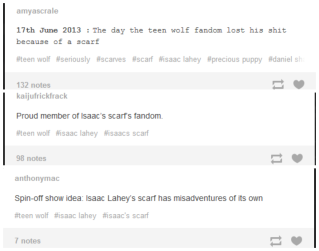Our group came to the consensus that globalization of culture has become a bit of a cycle. Thanks to the advent of the internet and social media, the relationship between audiences, consumers, and producers has become closer than ever. In today’s globalized, technologically advanced world, audiences have the ability to influence the media they consume or to even take on the identity of producers themselves.
One way in which audiences influence the media they consume is through creating active online communities based around different media. These “fandom” communities exist for a wide range of television shows, movies, and other media and they often produce their own theories, stories, videos, and other materials about the media that these worldwide fans are interested in. In turn, the ideas produced by these online fandoms can affect media production in a variety of ways, both big and small. One example of this occurred in the fandom surrounding the show Teen Wolf. In one episode from June 2013, Isaac, one of the teenage werewolves in the show, happened to wear a knit scarf:

Just a werewolf wearing a scarf.

Nothing unusual about that.
For some reason, Teen Wolf fans on Tumblr immediately went crazy over this scarf, repeatedly making references to and jokes about it on their blogs:

Tumblr reacts to the scarf via text posts….

…as well as picture edits.
Apparently, Teen Wolf fans’ love of the scarf eventually reached the creators of the show, as the scarf reappeared and was subsequently joked about within the context of a January 2014 episode. The reference was not lost on the fans:

Things come full circle as one of the other characters reacts to Isaac’s scarf during a recent episode. Fans rejoice.
While seemingly silly and innocuous, the Teen Wolf scarf incident provides a great example of just how blurred the lines between producers, consumers, and audiences have become, that something as simple as an article of clothing could become important enough for producers to take note of. Also, because Teen Wolf is an internationally popular show and fans in various countries commented on the situation, the incorporation of Isaac’s scarf into a joke within the show was actually prompted by an international audience.
Additionally, thanks to this international popularity, the incorporation of the scarf also serves as a way for producers of the show to advertise to their diverse audiences. The hype surrounding the scarf might in turn serve to inspire the many viewers of Teen Wolf to purchase scarves just like what they see the character wearing on TV. Therefore, it becomes a cycle, turning the audience from producers, back into consumers.
Another example of consumers taking on the identity of producers is through the use of internet platforms such as blogs and YouTube to produce original media and ideas. Web shows like the Misadventures of Awkward Black Girl or websites like MuslimGirl.net act as avenues for generally underrepresented and international audiences to become producers.
Finally, as one Rutgers student blogger, Kimberly, shows through her Pinterest, Tumblr, and YouTube pages, in this day and age, many of us have the capacity to be play a bit of producer and consumer. Kimberly calls her pages “A Bit Coquettish.” She uses these different pages to look up fashion trends and different designs, and critique them on her own. Her thoughts about these fashion lines fill her pages, and she has many followers that view the information she posts. Like other popular bloggers, Kimberly inhabits all three spheres of audience, producer, and consumer, a triple persona that media, internet, and globalization is slowly but surely making into a possible reality for anyone with an interest in media and an internet connection.
(Kimberly’s blog on WordPress: http://abitcoquettish.wordpress.com)






